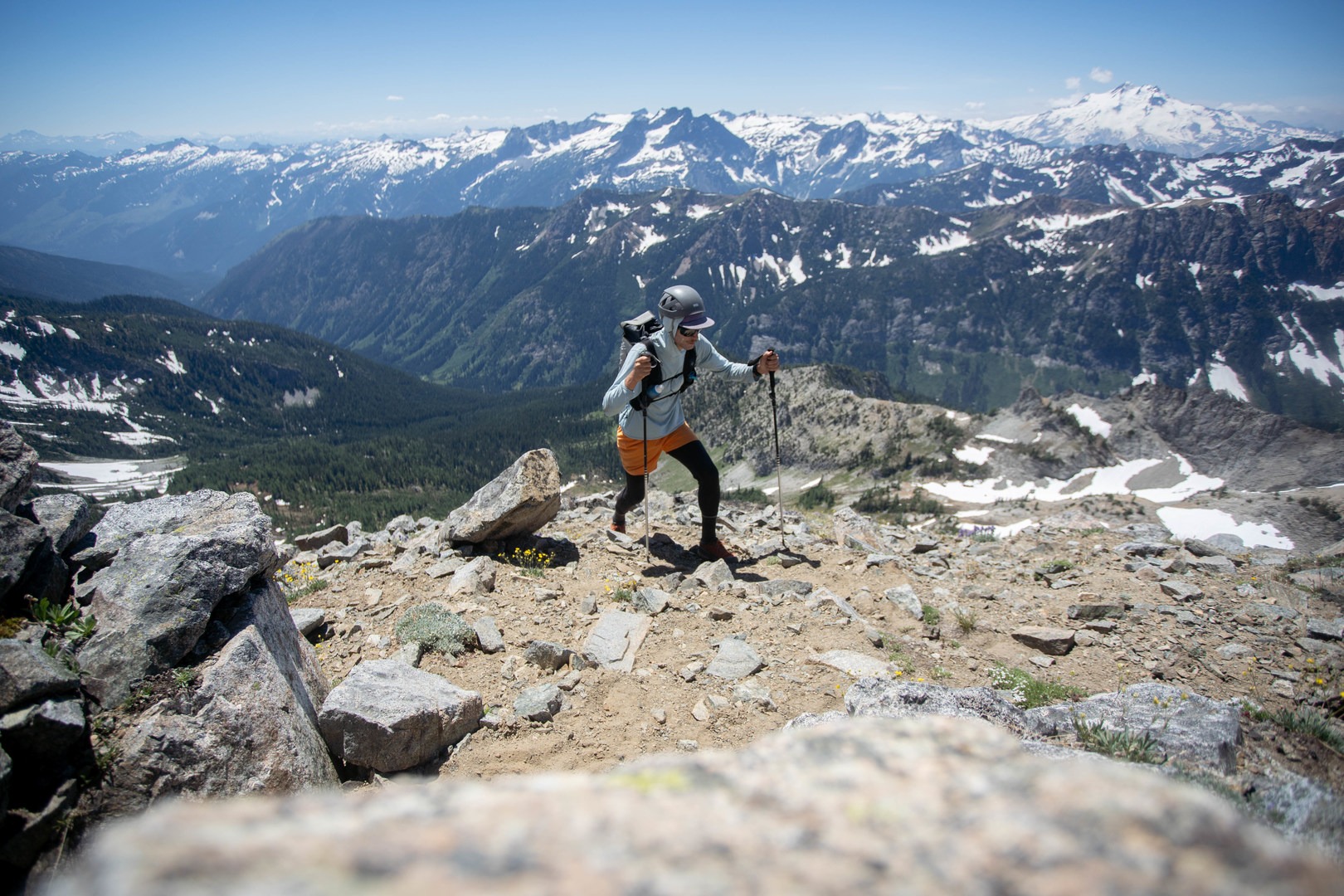You are here
Seven Fingered Jack (7FJ) is the twelfth highest peak in Washington and the seventh tallest nonvolcanic peak. And out of the tallest mountains in Washington, it may be one of the least technical (aside from Adams).
However, this doesn’t mean it’s a gimme. 7FJ is an aesthetic peak with seven unique towers set deep in the Glacier Peak Wilderness. And while it’s “just” a walkup, it’s a tough one, covered in loose rock and no clear trail.
If you’re breaking into bigger objectives or just want to tag a spectacular summit with great views, 7FJ is perfect. But don’t underestimate it - the loose rock can get pretty demoralizing, even if you’re a seasoned choss-aineer.
A disclaimer on this description and track - this off-trail line was traveled on a single day with certain conditions. The route described is a reasonable way to move through this terrain, and the description below mentions some of the hazards found during the trip. However, conditions may be significantly different when you visit this area. The advice in this trip report is not meant to be followed perfectly - you will need to adapt the route for the conditions you find and for your party’s abilities.
The Basics
-
Seasonality/Snow: 7FJ should generally be dry enough for dryland travel from mid-July to early October, though you can start tagging it as soon as the road opens up (or earlier if you're a real crusher).
-
Route Add-ons:
-
You can also tag Fernow and Mount Maude as they’re all along the same ridgeline, though it’ll be a lot of gain and a ton of routefinding.
-
-
Number of Days: You can do this as one big day, though most will do it in two or three days and tag other summits as well.
-
Navigation: Bring a map and/or a GPS, it can get a bit tricky out there.
-
Gear:
-
Good gear for scrambling and moving fast in the mountains.
-
Consider an ice axe and traction (microspikes/crampons) if it’s still early season.
-
-
Bad Road: The final few miles of road up to the Phelps Creek Trailhead can get really rutted out. You can probably drive it in a Subaru, but you’ll feel more comfortable in a higher clearance vehicle.
-
Warning: this is an off-trail route: Some maps (MapBuilder Topo on Caltopo and the Gaia GPS Map) have lines drawn on the map up 7FJ, implying that there is some sort of trail. AS OF SUMMER 2021, THERE IS NO TRAIL HERE. If you are looking for it, you will not find it. The description below will describe different ways up, none of which have established trails.
A Note on LNT
While Fernow is rugged and requires a ton of work to reach, the entire Phelps Creek Drainage gets a lot of travel. If you're contemplating Fernow, you have a lot of backcountry experience. Make sure you're modeling proper LNT behavior for newer backcountry visitors. Clean up after yourself and be a steward. Help others understand why these wild spaces are so special to you and do what you can to protect them, especially from off-trail travel, which can be destructive if done carelessly.
The Trip
To Leroy Basin
From the trailhead you’ll get views of 7FJ, looming Once you’ve made it up the road to the trailhead, head in along the beautiful Phleps Creek Trail. The trail gradually climbs through beautiful forests for 3.5 miles before crossing Leroy Creek. Immediately after the creek, you’ll cut right, heading straight up a steep trail that climbs 2k’ in ~1.5 miles. As you climb, you’ll start getting views of 7FJ.
Finally, you’ll reach Leroy Basin, a beautiful meadow. Set up camp if you’re doing an overnight, otherwise, keep trucking.
Climbing 7FJ
From Leroy Basin, follow the obvious trail trending east. You’ll cross over a small creek. On the eastern bank, you’ll see a trail heading straight up the slope. Follow it! The main trail heads southeast toward Maude.
Climb straight upslope for roughly 600’ before reaching a larch-covered bench. Continue up the faint trail before it fades away. Here, you’ve got a choice (and to reiterate the warning from above, there is not a trail here as of Summer 2021, despite some maps showing one).
Option 1: You can either follow the Gaia/Caltopo map and continue straight upslope up to 7800’ before cutting northwest, beneath the various summits of 7FJ to the true summit, which is the furthest north (climber’s left). This route is indirect and while you’ll find a variety of random cairns, it doesn’t make too much sense.
Option 2: Continue straight north, crossing below a prominent gully before ascending solid rock to a loose ridgeline. This is the “southwest ridge”. Head straight up the ridgeline, curving more east as you climb. At roughly 8400’, you’ll begin seeing more cairns. Continue straight up toward the climber’s left-most summit. After lots of loose rock, you’ll reach the summit.
Option 3: If it’s early season, you can climb straight up the snow-filled gully (climber’s right of the southwest ridge), gain the ridge and continue to the summit. This is probably the most direct route but requires a good amount of snow.
Once you’re at the summit, enjoy the panoramic views of Glacier Peak, Fernow (looking rugged just to the north), Maude, and many many other smaller peaks. After you’ve enjoyed the view, begin the long way back down, taking care on the loose terrain!
Logistics + Planning
Current Weather: Powered by Dark Sky
























Comments
Sign In and share them.